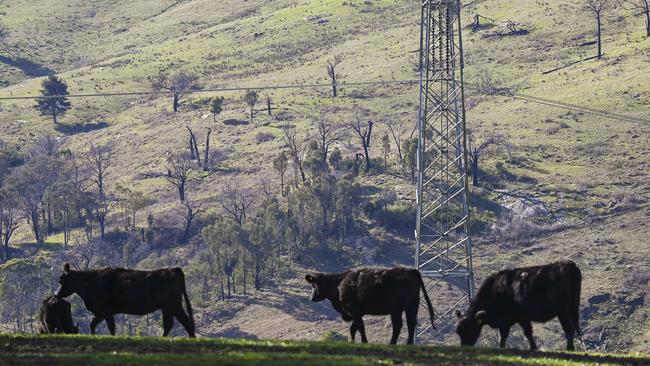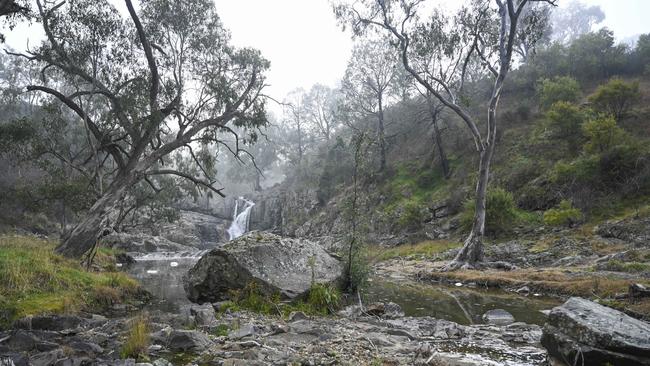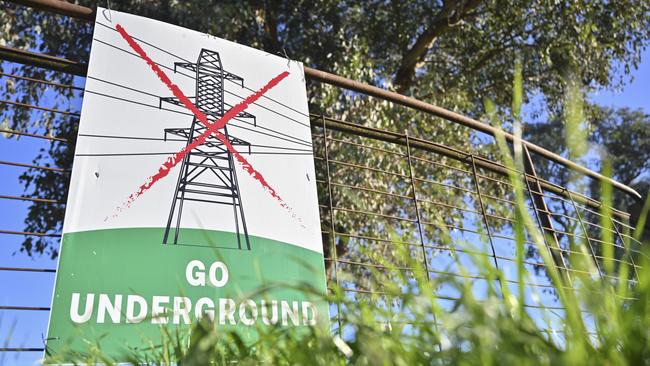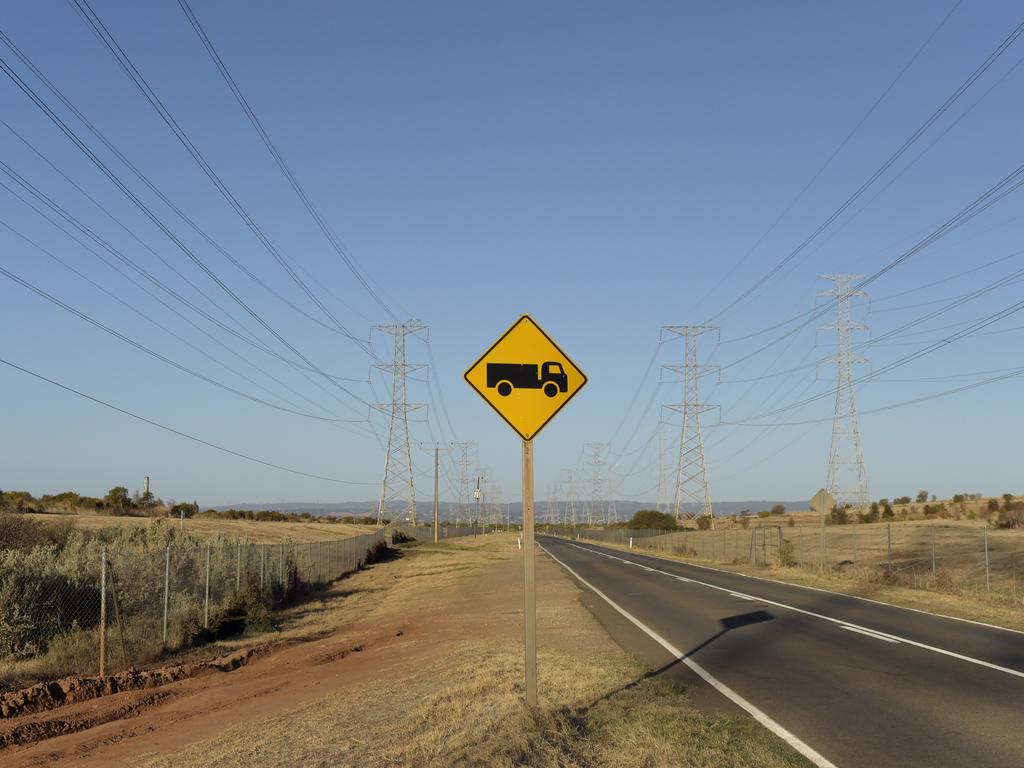Trandgrid’s HumeLink: the anguish and anger behind Australia’s clean energy plan
In rural pockets in the shadows of the Snowy Mountains, farmers are mounting a fierce campaign against new overhead power lines. Who will pay the most for the clean energy transition?

It’s known as the “energy superhighway”, a catchy slogan that holds the promise of a country on the move, speeding towards a clean energy world.
Fourth-generation Snowy Valleys landholder Dave Purcell pulls up a map of the transmission line superhighway and tries to picture what this vision of the future means for his family farm in this picturesque corner of southern NSW.
This is what he sees: eight to 14 steel towers, up to 76m-high, carrying cables that crisscross the sky above the cattle property like high-voltage cobwebs.
Not just on this farm, but a line of steel on 70m easements marching up the hills and down the green valleys that surround it.
“We’ll be massively impacted,’’ Purcell says, ticking off the pitfalls as his mother Louise gazes out the window of the family home near the orchard town of Batlow.
Intrusion on prime agricultural pastures, disruption to farming practices, devaluing of their land by at least 30 per cent, hindrance to firefighting activities – that’s a big one for a family who suffered so much in the 2019-20 fires that took every blade of grass, about 70 cattle and, worst of all, the life of a family friend who was helping to save the property.
‘The timing was terrible’
Neighbours tell similar stories, of trying to rebuild their blackened farms or razed homes while opening letters informing them that the HumeLink transmission project was coming, a more permanent alteration to their landscape.
“The timing was terrible. We were still coping with all of this when they started hounding us with phone calls day and night,’’ Purcell says. “We had to get solicitors involved. We were so devastated from the fires we couldn’t deal with them.’’
And so, like other landholders along Transgrid’s proposed HumeLink route, the Purcells simply shut their gates.
Feel-good buzzwords and superhighway slogans generated in city offices don’t mean much here in the western foothills of the Snowy Mountains. Stakeholder engagement teams with their bright smiles, soothing assurances and veiled threats of compulsory acquisition come and go, impeded by fences emblazoned with Stop signs barring access to the network operator, Transgrid.
Joe McGirr, the local NSW independent MP, says early consultation in the aftermath of the fires was unnecessarily adversarial. A bad start for a project requiring the agreement of hundreds of landowners.
The resistance runs deep. Snowy Valleys locals talk of motels and petrol stations turning away Transgrid workers; of organisations refusing the company’s offer of $5000 community grants even though they could do with the money to paint a clubhouse or buy new gear.
Behind many a “Stop HumeLink” sign there’s genuine anguish and anger. Impacted landholders will be compensated – $200,000 per kilometre of powerlines on their property, paid out over 20 years – but neighbours who have a giant tower built outside their home or business won’t.

Farmers who successfully agitated to have the route moved off their land have inadvertently pushed the 500kV lines onto outraged neighbours.
Longstanding friendships have been extinguished and neighbours divided as the winners and losers work out what has been gained and what will be lost.
There’s bewilderment that the race towards green energy will see further land-clearing and destruction of wildlife habitats, and it has widened the city and country divide. Nationals MP Wes Fang says his community is bearing the burden of “this overhead monstrosity’’ so city dwellers can have cheaper power.
“No one should minimise the consequences of ‘industrialising’ Australia’s iconic locations – would we build power lines above Bondi Beach?’’ the Snowy Valleys Council asked in a submission to a parliamentary inquiry.
Instead of speeding towards the future, HumeLink, one of the country’s biggest infrastructure projects and a critical link to connect renewable projects such as the beleaguered Snowy Hydro 2.0 to the electricity grid, has stalled in the face of community opposition along the length of the proposed 360km line from Wagga Wagga to Maragle to the south and Bannaby to the north.
Opponents have been accused of holding the country to ransom, delaying the race to build sufficient renewable electricity to replace coal-fired power stations as they close.
Transgrid says HumeLink is critical to the release of more affordable, reliable and renewable energy, but CEO Brett Redman has foreshadowed that the original $3.3bn budget has already blown out to nearly $5bn.
The federal government’s $20bn Rewiring the Nation plan requires 10,000km of new high-voltage power lines across the country’s east coast, but local communities from Tasmania to Queensland aren’t copping new overhead lines without a fight, and they’re emboldened by the HumeLink protest and the equally fierce resistance in Victoria to the VNI West project (Victoria to NSW Interconnector West).
Environmentalist Bob Brown is leading the protest against the $3.5bn Marinus Link undersea cable between Victoria and Tasmania, saying it will enable environmentally destructive projects in his state.
In the Sunshine Coast hinterland near Gympie, locals are up in arms over Powerlink’s plans for transmission lines to connect pumped hydro to the grid.
Of the country’s major transmission projects, the 900km EnergyConnect project west from Wagga Wagga to Robertstown in South Australia, connecting to Red Cliffs in Victoria, is under construction.
The gridlock threatens to derail the federal government’s clean energy transition and has forced Energy Minister Chris Bowen to establish a “community engagement review” to ensure better consultation with communities and proper handling of complaints. “It would be easy, but wrong, to dismiss those concerns as just NIMBY-ism,’’ he said in a speech last May. “In my experience, most concerned community members are not anti-renewables, anti-transmission or anti-progress. Nor, in most cases, are they opposed to the projects going ahead if their concerns are addressed.”
The HumeLink landholders who spoke to The Weekend Australian aren’t against renewables. They’re not anti-progress or rednecks. Many have spent time and money researching the options, hiring experts, looking for ways to make this work.
They know that transmission is necessary and that their properties are in the firing line, and so they have come up with an alternative plan: bury the cables.
The NSW government has responded to their concerns by holding a parliamentary inquiry into the feasibility of undergrounding the lines. More than three years into the battle, it’s given the landholders hope.
“Everyone is happy to work with them if they put it underground,’’ Dave Purcell says. “They could come on to the property and start working tomorrow if that was the option.’’
Communities divided
Mary-Jane Betts is driving across her sheep property just west of Yass, pointing out the lines of trees planted by her late dad John Betts, an early and enthusiastic Landcare member who understood the need for sustainable farming practices and regeneration.
This very afternoon her mum Nan, an active 84-year-old, is down by the creek digging up river red gum seedlings that she’ll nurture and replant elsewhere on the property. Rainbows of parrots erupt from the trees as we survey a deep gully with a generous waterfall spilling from the rocks.
A wedge-tailed eagle is disturbed from its twiggy nest and soars overhead as Mary-Jane talks about the history of this part of Derringullen Creek and its significance as a women’s area for the original Ngunnawal people.
Eight towers, each as high as the pylons on the Sydney Harbour Bridge, over of distance of 3.1km are slated for this property.
She shakes her head in disbelief that the route will cross this very gully, away from the women’s area but most likely skirting the eagle’s nest, and taking out ancient trees and newer plantings and wildlife corridors nurtured by her family.

The route, including a 70m easement, will most likely go up through the best lambing paddocks and the helicopter landing pad needed for aerial land management in the steeper, more inaccessible country.
Unlike farmers further south she has asked Transgrid’s mapping team to come onto the property, to see from the ground what can’t be spotted from satellite maps.
These generational farmers know the contours of their land as well as the features on their face. “This place is deep in our bones,’’ Mary-Jane says. “It is absolutely soul-destroying and it hurts us deeply to see what they’re planning to do and at the way we are being treated.
“I hate that this has made me so angry because we are not angry people.”
If the lines must go above ground she has come up with an alternative route within Transgrid’s 200m corridor, but it’s all up in the air, along with her plans to build a conservation trail and eco lodge down at the waterfall.
“We can’t plan anything until we know where these lines are going. We’ve had to put everything on hold while we try to fight this. I can’t tell you how bad it’s been for our health,’’ she says.

The words of Transgrid’s Brett Redman at the parliamentary inquiry this week would do little to placate her. He insists he understands the difficulties that landowners face. Rebuilding the energy network throws up wicked problems. Trangrid recognises the importance of meaningful community engagement, the need to consider the perspectives of impacted communities.
He’s visited properties, talked with farmers. “There is no doubt that these big linear projects have significant impact on landowners who have lived and worked on their properties, in some cases, for many, many generations. I can’t shy away from that. Money alone will not compensate for it,’’ he said.
In the farming community at Darlow, just west of Tumut, the Smith family are all too aware of the burdens that come with HumeLink. Their Hereford stud property Glenellerslie wasn’t in the original route. But when landholders further up the valley protested, the line was moved and will now run through the Smiths’ property, in full view outside their kitchen window.
“It’s ripped the community apart,’’ says Ross Smith, sitting in his farmhouse with his son Blake. Longstanding friends and neighbours no longer speak.

His wife Mandy painted a vivid portrait of the effects in her submission to the inquiry. “We very sadly became impacted due to our own community pushing HumeLink off themselves and onto us.
“I have felt isolated and withdrawn from our community as a result, after being an active and supportive community member. I was contemplating suicide in June/July last year, when my family and doctor intervened, and ambulance and police were called, which was a traumatic time for all of us. I felt that life wasn’t worth living and in the next fire we are doomed. ‘’
Ross talks of this as a very dark time for the family still grieving the loss of son Lachlan in a farming accident in 2013. The ability to defend their property against bushfires is a key concern. Ross points up the hills where the 2019-20 fires raged. Like many farmers, including the Purcells, they have existing 330kV lines on smaller towers built on their land in the 1970s.
As he was defending his property he saw what happened when the smoke reached the existing high-voltage line, causing it to arc to the ground in a flash of fire with a loud bang.
“It was only afterwards that I found out that RFS (Rural Fire Service) will not send any appliances, ground or air, to fight fires near high-voltage lines. We have asked Transgrid how they can protect us from fires burning near transmission lines and they have no answer.’’
There’s another strand to the opposition along the HumeLink corridor and it’s not just the visual effects. It’s the environmental damage. The loss of trees and wildlife habitats, the careful work carried out by people like John Betts and his family.

The Riverina Highlands Landcare Network says endangered ecological areas in the Landcare network are under threat. “We are very concerned about the impact this project will have on these sites as well as the impact this is having on our members.”
The Nature Conservation Council of NSW, which represents more than 180 environment groups, also speaks to the need to balance the renewable energy transition with the impact on the environment.
“Renewable energy zones are seeing large areas of land cleared for new green energy facilities and transmission, and communities grappling with the challenges of the transition,’’ the organisation said in a submission to the inquiry.
“The construction of above-ground transmission lines could remove thousands of hectares of habitat and cause further fragmentation and loss of connectivity at a massive scale.’’
The solution, it says, is to put the lines underground in areas of high environmental, social or cultural significance. “We acknowledge that there is a higher cost associated with international best-practice underground connections. However, in a climate and biodiversity crisis, and when the vast majority of the public want more done to protect nature, financial cost can no longer be the only determining factor.’’
Matter of money
The cost of installing power lines underground has opened up a gulf as wide as the Snowy Mountains, with claim and counter claim coming from Trangrid, various experts and the community.
It’s why the NSW parliamentary inquiry was called – to deal with this question once and for all. “It’s an opportunity for undergrounding of HumeLink to be truly, fully and transparently considered,’’ McGirr said.
Transgrid says the underground option would be three to 10 times more expensive, would delay the project by three to five years and would still have environmental impacts from excavation and trenching works. There’s a lot at stake for the country. “If HumeLink is not delivered on time in 2026, it will jeopardise network reliability,’’ Redman said.
Opponents have done their own studies and dispute Transgrid’s estimates, saying experts have said it will cost two times as much to go underground. They argue that Transgrid has not factored in the true costs.
“There is no mention of the external costs, such as bushfires, nor the cost impact on communities, on the mental health of the nearby residents, or on native birds and animals losing vast areas of habitat,’’ landholder Michael Katz told the inquiry. Other developed countries can go underground, he argues, so why not Australia?

Further up the HumeLink route near Bannister, Russ Erwin stands at the top of his property and looks at the wind farms that now encircle this district.
The proposed new 500kV lines would go through his property and, like many other landholders, he’s concerned that it won’t stop there, that more high-voltage power lines will follow to feed electricity up and down the east coast.
The race to renewables can’t be at the cost of prime agricultural country, livelihoods and communities, he says. He looks at the trees he’s planted, the work done to regenerate the property. He recalls how John Betts from Yass used to come here to collect seeds to rewild other areas in the district.
“The burden is falling on rural people,’’ he says. “We have to look at what this means for those communities and for the environment. We need to preserve this landscape for future generations.”






To join the conversation, please log in. Don't have an account? Register
Join the conversation, you are commenting as Logout